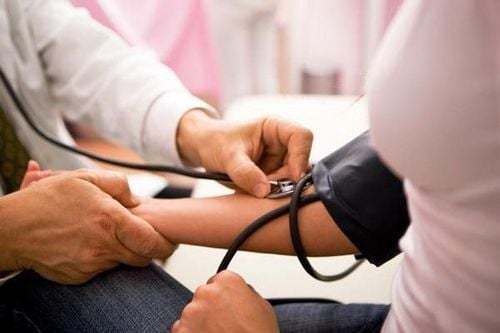This is an automatically translated article.
Distributive shock is a severe decrease in vascular resistance that exceeds the compensation of increased cardiac output. Shock causes systemic tissue hypoperfusion, tissue oxygen demand and supply imbalance, and tissue hypoxia.
1. What is stun?
Shock is considered a condition in which the blood supply of essential nutrients to tissues and organs in the human body is insufficient. Ultimately, shock results in membrane dysfunction, cell metabolism disturbances, and cell death.
Shock often causes systemic tissue hypoperfusion, tissue hypoxia, and tissue oxygen demand and supply imbalance. The stages of the stun include:
Stage 1 stun: Also known as compensated stun. Compensated shock makes it difficult to recognize symptoms. If detected and treated in time, recovery is possible. Some possible manifestations such as tachycardia, slight decrease in blood pressure, restlessness... Stage 2: This is a form of decompensated shock, causing reduced blood perfusion to the patient's organs such as: : Brain ( perceptual disturbance ); kidneys (oliguria); heart (myocardial ischemia). Symptoms are easy to recognize such as rapid and difficult pulse, low blood pressure, peripheral vasoconstriction, purple extremities, sweating. Stun stage 3: Stun does not heal. This is a state of prolonged tissue hypoperfusion leading to changes in cell membrane function, blood cell aggregation in the microcirculation causing capillary blockage and cell damage.
2. What is distributional shock?
Distributive shock is a severe decrease in vascular resistance that exceeds the compensation of increased cardiac output. In addition to shock due to fluid distribution, there are also the following types of shock:
Hypovolemic shock : Hypovolemic shock is the most common. The cause is due to a decrease in the absolute amount of intravascular fluid compared to the capacity of the vascular system, reducing the amount of blood to the right ventricle, leading to a decrease in cardiac output. If hypovolemic shock persists for several hours, the risk of death for the patient is high. In particular, in cases where the patient has cardiovascular, respiratory, kidney, and brain diseases, the state of shock will be much more dangerous. Cardiogenic shock: Cardiomyopathy due to diseases such as acute myocardial infarction, severe valvular disease, aortic valve stenosis. Obstructive shock: An obstruction of blood flow will result in a decrease in diastolic filling pressure or an excessive increase in afterload. Causes are tension pneumothorax, cardiac tamponade, constrictive pericarditis, pulmonary embolism.
3. Complications of shock

Choáng có thể gây ra tình trạng bị đông máu nội mạch lan tỏa
Complications of shock due to fluid distribution and other types of shock cause the following complications:
Shock causes disseminated intravascular coagulation: This is a common complication in shock. This is because intravascular coagulation and fibrinolysis occur at the same time. Clinical symptoms are bleeding, causing renal cortical necrosis, organ damage. Pulmonary shock: Pulmonary shock is a state of acute non-cardiac pulmonary edema, acute respiratory failure with severe hypoxemia. X-ray showed extensive pulmonary infiltrates. Acute renal failure: The main cause is decreased renal perfusion in the state of hypotension. The clinical diagnoses were oliguria, anuria, and elevated blood urea and creatinine. Shock causes complications on the liver, heart, brain: In the liver, it causes acute liver damage with signs of increased liver enzymes, increased bilirubin... For the heart, if blood pressure drops < 60 mmHg, severe acidosis will cause decreased muscle contractions heart resulting in decreased cardiac output. With the brain, when blood pressure is severely reduced, acidosis is severe, blood oxygen is reduced, and blood sugar is low, the patient will have signs of restlessness, lethargy, confusion, and coma.

Sử dụng thuốc vận mạch giúp điều trị choáng
When this complication occurs, the general measures to treat shock are:
Give the patient oxygen Ventilate when needed. Sufficient circulating volume. Use vasopressors. Correction of electrolyte disturbances, acid-baseline... Monitor blood pressure, breathing rate, Sp02, urine output,.. In summary, shock due to fluid distribution is a condition that requires prompt emergency treatment to prevent To prevent dangerous complications for the patient, as soon as there is a phenomenon of shock, it is necessary to take the patient to a reputable hospital for timely examination by a specialist. Currently, Vinmec International General Hospital is one of the leading prestigious hospitals in the country, trusted by a large number of patients for medical examination and treatment. Not only the physical system, modern equipment: 6 ultrasound rooms, 4 DR X-ray rooms (1 full-axis machine, 1 light machine, 1 general machine and 1 mammography machine) , 2 DR portable X-ray machines, 2 multi-row CT scanner rooms (1 128 rows and 1 16 arrays), 2 Magnetic resonance imaging rooms (1 3 Tesla and 1 1.5 Tesla), 1 room for 2 levels of interventional angiography and 1 room to measure bone mineral density.... Vinmec is also the place to gather a team of experienced doctors and nurses who will greatly assist in diagnosis and detection. early signs of abnormality in the patient's body. In particular, with a space designed according to 5-star hotel standards, Vinmec ensures to bring the patient the most comfort, friendliness and peace of mind.
Please dial HOTLINE for more information or register for an appointment HERE. Download MyVinmec app to make appointments faster and to manage your bookings easily.













